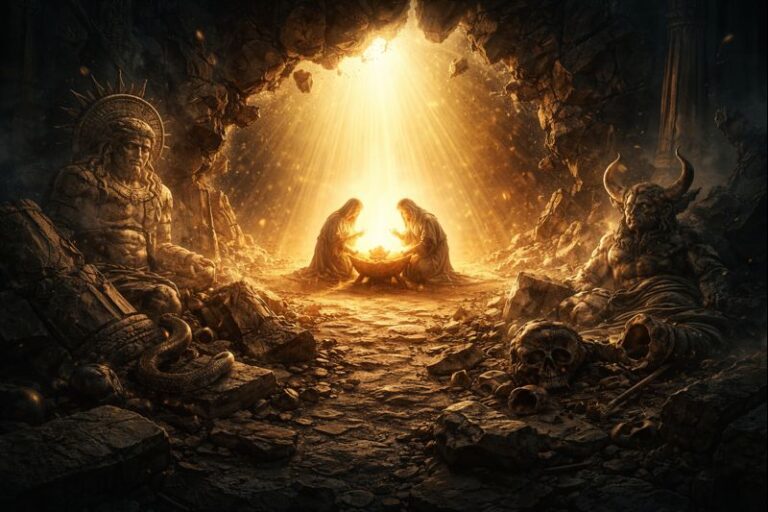
The Bible presents Satan as the first rebel, deceiving humanity in Eden and setting himself in opposition to Yahweh’s purposes from the very beginning. But when God disinherits the nations at Babel (Deuteronomy 32:8-9), there is no indication that Satan is assigned a nation. The divine council sons of God are given authority over the nations, and Yahweh retains Israel for Himself. Satan is nowhere in that picture.
This is not surprising. Satan had already rebelled. He had already introduced sin into the world and brought death through deception. Why would he be entrusted with a nation? He would not be, and he was not.
But he would not stay excluded.
The Rebellion of the Gods
Psalm 82 shows that the gods of the nations, the ones given legitimate rule over the peoples, eventually rebelled. They pervert justice, show partiality, and demand worship for themselves. They become corrupt stewards, and Yahweh condemns them to die like men.
The Opportunist Behind the Curtain
It is in this spiritual vacuum that Satan likely saw his opportunity. The pattern is familiar. Just as he deceived Eve, it is plausible that he seduced the other elohim as well. He may have promised them greatness, freedom from Yahweh, or worship for themselves. Perhaps he did not originate their rebellion, but he certainly seems to have benefited from it. Over time, as the gods of the nations fought among themselves through their human empires, Satan emerged as the one spirit behind them all.
The Rise of the King of the Gods
We can see this in the way ancient religion developed. The gods of Egypt, Canaan, Babylon, Greece, and Rome were originally distinct, but as empires grew and conquered one another, their gods merged. Baal rose in Canaan. Marduk overtook the other gods of Babylon. Zeus became king of Olympus and was later identified with Jupiter in Rome. At each step, the god at the top took on more authority, often absorbing characteristics of the others.
The altar of Zeus at Pergamum, described in Revelation 2:13 as the throne of Satan, confirms the trajectory. Zeus had become the highest god of the pagan world. His altar stood like a throne on a high place. Jesus identifies that location not just as idolatrous, but as Satan’s seat. This implies that Satan, though never given a nation by God, had risen through the corruption of the divine order to become the ruler over the fallen gods.
The Usurper’s Claim
This also explains why Satan could offer Jesus all the kingdoms of the world in Matthew 4. He claimed authority over what was not given to him, a stolen reign that came through deceit and manipulation. He was not a rightful king. He was a usurper.
The True King Reclaims the Nations
But his rule did not go unchallenged. At the cross, Christ disarmed the rulers and authorities and exposed them. His resurrection declared Him the rightful heir of the nations. His ascension stripped Satan of his access to any real authority. The rebel bene elohim were still around and in full rebellion, but they no longer had the authority given to them by Yahweh.
Conclusion
Satan began as a deceiver, not a ruler. He was not given a territory, but he took one anyway. Through the rebellion of the gods of the nations, he found his place among them, rising above them as the counterfeit king of a crumbling empire. But his dominion is temporary, and his defeat is certain.
The nations belong to Christ.
Discussion Questions
- According to Deuteronomy 32:8–9, what happened at Babel, and why is Satan notably absent from the divine allotment of the nations?
- How does Psalm 82 reveal the failure of the gods of the nations, and what does Yahweh’s judgment against them imply about their original roles?
- What evidence do we have that Satan may have seduced or taken advantage of the rebellion of other spiritual beings to elevate his own position?
- Why is the reference to Pergamum as the “throne of Satan” in Revelation 2:13 significant for understanding Satan’s association with Zeus and pagan rule?
- How does Christ’s death and resurrection serve as a turning point in spiritual authority, and what does this mean for the current rule of Satan over the nations?
Sources of Additional Information
- Michael S. Heiser, The Unseen Realm: Recovering the Supernatural Worldview of the Bible
— A foundational work that explores the divine council, Deuteronomy 32, Psalm 82, and the spiritual geography of the nations. - 1 Enoch (Chapters 6–15)
— A key Second Temple text preserved in the Dead Sea Scrolls, describing the rebellion of the Watchers. While Satan is not central in these chapters, the rebellion of divine beings forms an important backdrop. - The Dead Sea Scrolls: Community Rule (1QS), War Scroll (1QM), and Testament of Amram (4Q543–549)
— These texts present Belial as a Satan figure who commands other spirits and opposes the sons of light, offering insight into Second Temple demonology and spiritual conflict. - Tremper Longman III and John H. Walton, The Lost World of the Torah
— Offers solid scholarly insight into Ancient Near Eastern worldview, including divine authority structures and how they shape biblical theology. - Derek P. Gilbert, The Second Coming of Saturn: The Great Conjunction, America’s Temple, and the Return of the Watchers
— Although speculative in places, this book is grounded in real texts and archaeological research. It discusses Saturn (as a god associated with the rebel Watchers), Pergamum, and how Satan took control over spiritual dominions.




